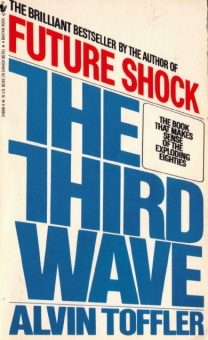BEYOND MASS PRODUCTION
Today’s machines compress these five steps into one, making thesequential all but simultaneous.
To learn how-—and to speed up my own work—I bought a simple computer, used it as a word processor, and wrote the latter half of this book on it. To my pleasure, I found I could master the machine in a single short session. Within a few hours I was using it fluently. After more than a year at the keyboard I am still amazed by its speed and power.
Today, instead of typing a draft of a chapter on paper, I type on a keyboard that stores it in electronic form on what is known as a “floppy disk.” I see my words displayed before me on a TV-like screen. By punching a. few keys I can instantly revise or rearrange what I have written, shifting paragraphs, deleting, inserting, underlining, until I have a version I like. This eliminates erasing, “whiting out,” cutting, pasting, stripping, Xeroxing, or typing successive drafts. Once I have corrected the draft, I press a button, and a printer at my side makes a Jetter- perfect final copy for me at vision-blurring speeds.
But making paper copies of anything is a primitive use of such machines and violates their very spirit. For the ultimate beauty of the electronic office lies not merely in the steps saved by a secretary in typing and correcting letters. The automated office can file them in the form of electronic bits on tape or disk. It can (or soon will) pass them through an electronic dictionary that will automatically correct their spelling errors. With the machines hooked up to one another and to the phone lines, the secretary can instantly transmit the letter to its recipient’s printer or screen. The equipment thus can capture an original, correct it, duplicate it, send it, and file it in what amounts virtually to a single process. Speed increases. Costs go down. And the five steps are compressed into one.
The implications of this compression extend far outside the office. For among other things, this equipment, linked to satellites, microwave, and other telecommunications facilities, makes it possible to end-run that overworked, malfunctioning, classically Second Wave institution, the Post Office. Indeed, the spread of office automation, of which word processing is only a single small aspect, is integrally linked to the creation of “electronic mail” systems to replace the postman and his burdensome bag.
In the United States today, fully 35 percent of total domestic postal volume consists of transaction reports: bills, receipts, purchase orders, invoices, bank statements, checks, and the like. However, a vast amount of mail flows not between individuals but between organizations. As the postal crisis has deepened, more and more companies have sought an alternative to the Second Wave postal system and begun to build pieces of a Third Wave system instead.
190
Pages: 1 2 3 4 5 6 7 8 9 10 11 12 13 14 15 16 17 18 19 20 21 22 23 24 25 26 27 28 29 30 31 32 33 34 35 36 37 38 39 40 41 42 43 44 45 46 47 48 49 50 51 52 53 54 55 56 57 58 59 60 61 62 63 64 65 66 67 68 69 70 71 72 73 74 75 76 77 78 79 80 81 82 83 84 85 86 87 88 89 90 91 92 93 94 95 96 97 98 99 100 101 102 103 104 105 106 107 108 109 110 111 112 113 114 115 116 117 118 119 120 121 122 123 124 125 126 127 128 129 130 131 132 133 134 135 136 137 138 139 140 141 142 143 144 145 146 147 148 149 150 151 152 153 154 155 156 157 158 159 160 161 162 163 164 165 166 167 168 169 170 171 172 173 174 175 176 177 178 179 180 181 182 183 184 185 186 187 188 189 190 191 192 193 194 195 196 197 198 199 200 201 202 203 204 205 206 207 208 209 210 211 212 213 214 215 216 217 218 219 220 221 222 223 224 225 226 227 228 229 230 231 232 233 234 235 236 237 238 239 240 241 242 243 244 245 246 247 248 249 250 251 252 253 254 255 256 257 258 259 260 261 262 263 264 265 266 267 268 269 270 271 272 273 274 275 276 277 278 279 280 281 282 283 284 285 286 287 288 289 290 291 292 293 294 295 296 297 298 299 300 301 302 303 304 305 306 307 308 309 310 311 312 313 314 315 316 317 318 319 320 321 322 323 324 325 326 327 328 329 330 331 332 333 334 335 336 337 338 339 340 341 342 343 344 345 346 347 348 349 350 351 352 353 354 355 356 357 358 359 360 361 362 363 364 365 366 367 368 369 370 371 372 373 374 375 376 377 378 379 380 381 382 383 384 385 386 387 388 389 390 391 392 393 394 395 396 397 398 399 400 401 402 403 404 405 406 407 408 409 410 411 412 413 414 415 416 417 418 419 420 421 422 423 424 425 426 427 428 429 430




